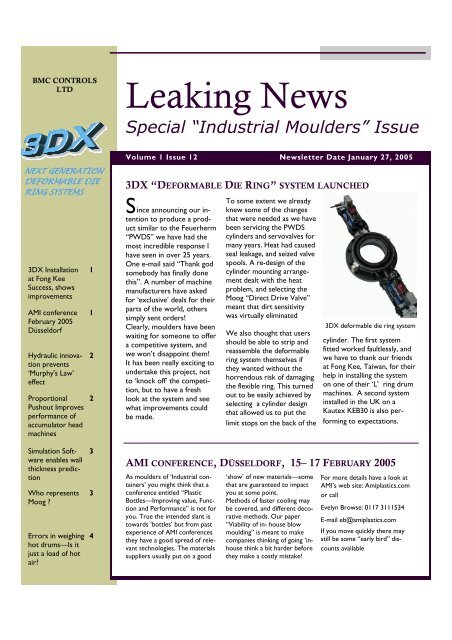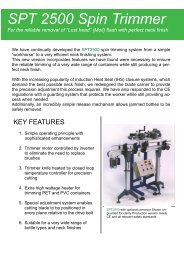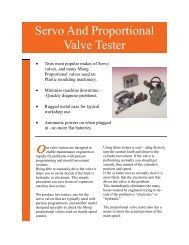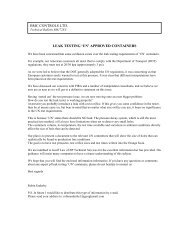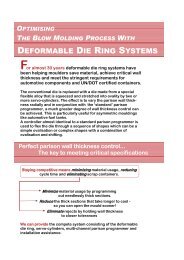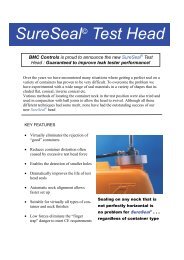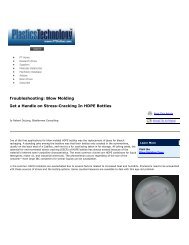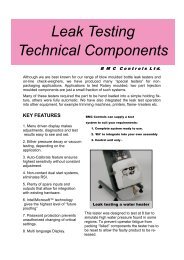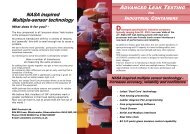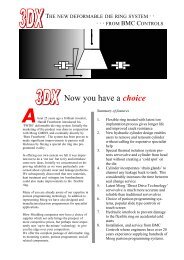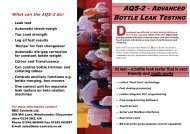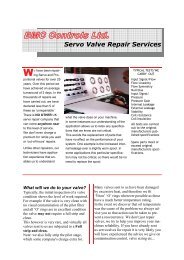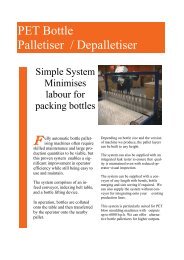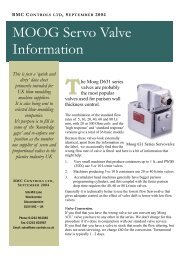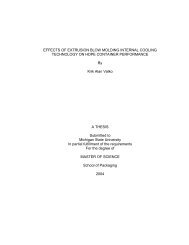3DX Newsletter - Blow Moulding Controls
3DX Newsletter - Blow Moulding Controls
3DX Newsletter - Blow Moulding Controls
Create successful ePaper yourself
Turn your PDF publications into a flip-book with our unique Google optimized e-Paper software.
BMC CONTROLS<br />
LTD<br />
Leaking News<br />
Special “Industrial Moulders” Issue<br />
NEXT GENERATION<br />
DEFORMABLE DIE<br />
RING SYSTEMS<br />
<strong>3DX</strong> Installation<br />
at Fong Kee<br />
Success, shows<br />
improvements<br />
AMI conference<br />
February 2005<br />
Düsseldorf<br />
Hydraulic innovation<br />
prevents<br />
‘Murphy's Law’<br />
effect<br />
Proportional<br />
Pushout Improves<br />
performance of<br />
accumulator head<br />
machines<br />
1<br />
1<br />
2<br />
2<br />
Volume 1 Issue 12<br />
<strong>Newsletter</strong> Date January 27, 2005<br />
<strong>3DX</strong> “DEFORMABLE DIE RING” SYSTEM LAUNCHED<br />
To some extent we already<br />
S ince announcing our intention<br />
to produce a prod-<br />
that were needed as we have<br />
knew some of the changes<br />
uct similar to the Feuerherm been servicing the PWDS<br />
“PWDS” we have had the cylinders and servovalves for<br />
most incredible response I many years. Heat had caused<br />
have seen in over 25 years. seal leakage, and seized valve<br />
One e-mail said “Thank god spools. A re-design of the<br />
somebody has finally done cylinder mounting arrangement<br />
dealt with the heat<br />
this”. A number of machine<br />
manufacturers have asked problem, and selecting the<br />
for ‘exclusive’ deals for their Moog “Direct Drive Valve”<br />
parts of the world, others meant that dirt sensitivity<br />
simply sent orders!<br />
was virtually eliminated….<br />
Clearly, moulders have been ……………<br />
<strong>3DX</strong> deformable die ring system<br />
waiting for someone to offer We also thought that users<br />
a competitive system, and should be able to strip and cylinder. The first system<br />
we won’t disappoint them! reassemble the deformable fitted worked faultlessly, and<br />
It has been really exciting to<br />
ring system themselves if we have to thank our friends<br />
undertake this project, not<br />
they wanted without the at Fong Kee, Taiwan, for their<br />
to ‘knock off’ the competition,<br />
but to have a fresh<br />
horrendous risk of damaging help in installing the system<br />
the flexible ring. This turned on one of their ‘L’ ring drum<br />
out to be easily achieved by machines. A second system<br />
look at the system and see<br />
selecting a cylinder design installed in the UK on a<br />
what improvements could<br />
that allowed us to put the Kautex KEB30 is also performing<br />
to<br />
be made.<br />
limit stops on the back of the<br />
expectations.<br />
Simulation Software<br />
enables wall<br />
thickness prediction<br />
Who represents<br />
Moog ?<br />
Errors in weighing<br />
hot drums—Is it<br />
just a load of hot<br />
air?<br />
3<br />
3<br />
4<br />
AMI CONFERENCE, DÜSSELDORF, 15– 17 FEBRUARY 2005<br />
As moulders of ‘Industrial containers’<br />
you might think that a<br />
conference entitled “Plastic<br />
Bottles—Improving value, Function<br />
and Performance” is not for<br />
you. True the intended slant is<br />
towards ‘bottles’ but from past<br />
experience of AMI conferences<br />
they have a good spread of relevant<br />
technologies. The materials<br />
suppliers usually put on a good<br />
‘show’ of new materials—some<br />
that are guaranteed to impact<br />
you at some point. ……<br />
Methods of faster cooling may<br />
be covered, and different decorative<br />
methods. Our paper<br />
“Viability of in- house blow<br />
moulding” is meant to make<br />
companies thinking of going ’inhouse<br />
think a bit harder before<br />
they make a costly mistake!...<br />
For more details have a look at<br />
AMI’s web site: Amiplastics.com<br />
or call<br />
Evelyn Browse: 0117 3111534<br />
E-mail eb@amiplastics.com<br />
If you move quickly there may<br />
still be some “early bird” discounts<br />
available
Page 2<br />
Leaking News<br />
<strong>3DX</strong> — HOW DOES IT WORK, AND DO YOU NEED IT?<br />
Anyone not familiar with systems like the<br />
Feuerherm PWDS may be wondering what<br />
on earth this is all about, so here is the absolute<br />
beginners guide.<br />
A ‘conventional’ parison programmer varies<br />
the wall thickness over the length of the parison.<br />
If you measure the moulding around its<br />
circumference you may find significant variations,<br />
particularly on the parting line near the<br />
base and top corners. The degree of circumferential<br />
thickness variation is also dependant<br />
on the shape of the moulding and can be<br />
totally unacceptable on asymmetric mouldings<br />
like automotive fuel tanks. Machining the die<br />
or core to an ovalised shape can compensate<br />
for this effect, but the amount of ovalisation is<br />
fixed, and only optimum for specific parts of<br />
the moulding. What is needed is varying amounts of<br />
ovalisation at different points on the moulding.<br />
The <strong>3DX</strong> system uses hydraulic cylinders to pull<br />
and push a ring into a programmed series of<br />
shapes. Although usually aligned to the mould parting<br />
line, the system can also be mounted 90° if this<br />
is more convienent. The flexible die ring can be<br />
pre-squeezed into ovality, shifted from side to side<br />
and pulled outward and pushed inward either side<br />
of ’round’ just by setting the programming unit.<br />
Although the system can be used to save weight,<br />
it’s main usage is to improve the performance of<br />
the moulding such as achieving better drop test<br />
strength or maintaining minimum wall thickness.<br />
Most ‘UN’ containers are made with the help of a<br />
deformable die ring to meet stingent tests.<br />
“Murphys law:<br />
If something<br />
can go wrong it<br />
will.<br />
<strong>3DX</strong> Law:<br />
At least try and<br />
prevent it<br />
happening<br />
NEW HYDRAULIC SAFETY SYSTEM HELPS PREVENT EXPENSIVE DAMAGE<br />
There is one thing that deformable<br />
die ring systems really<br />
don't like and that is an accidental<br />
‘cold start’.<br />
The force from the parison<br />
programming cylinder is so<br />
powerful that it can easily damage<br />
the flexible ring if the material<br />
between the core and die is<br />
solid. You would think that all<br />
you need to do is to interlock<br />
the hydraulic start with the<br />
temperature controllers ’alarm<br />
output’ and hey presto, prob-<br />
lem fixed. Firstly many of the<br />
older machines may not have<br />
temperature controllers<br />
equipped with a low temperature<br />
alarm output, secondly, it<br />
can be beneficial to have the<br />
hydraulic oil circulating when<br />
the ‘heats’ are on to carry away<br />
the heat from the deformable<br />
ring cylinders. Our solution<br />
was to fit a solenoid valve under<br />
the servovalves to bypass<br />
the flow until the die temperature<br />
is at a safe level. Not only<br />
does this remove heat from the<br />
servovalves it also allows the<br />
system to carry out a low pressure<br />
flushing cycle. We have<br />
also fitted a separate thermocouple<br />
receptacle for independently<br />
monitoring the die<br />
temperature for our cold start<br />
prevention system. This gives<br />
an extra level of safety in the<br />
event the machines temperature<br />
controller is faulty or a<br />
heater band goes open circuit.<br />
STATICALLY DEFORMABLE CORE — MORE DEVELOPMENT NEEDED?<br />
The device known as ‘SFDR’ consists<br />
of a thin ring that can be<br />
deformed by a series of bolts to<br />
enable a shaped core to be produced<br />
without the time consuming<br />
’hit and miss’ process of machining<br />
a core. This idea is extremely<br />
simple, but quite expensive<br />
to produce. Once the shape<br />
is optimized to a particular container<br />
you won’t want to disturb<br />
these settings, so you might need<br />
to think about keeping a deformable<br />
core for every job.<br />
We're looking into ways of getting<br />
the cost down and developing a<br />
‘setting device’ that can be used to<br />
re-set the core to a previously optimized<br />
shape. This is looking quite<br />
feasible, and we hope to give you<br />
more details soon. The photo shows<br />
a 220mm diameter ‘statically deformable’<br />
core we recently supplied as an<br />
example of our capability, and remember,<br />
we are happy to supply<br />
components like this as well as complete<br />
systems. We are also extending<br />
the range down to smaller diameters<br />
for non-industrial sized containers.<br />
These will have considerably fewer setting screws, but will<br />
still enable moulders to optimize ovalisation on a wide<br />
range of container shapes.
Volume 1 Issue 12<br />
Page 3<br />
PROPORTIONAL PUSH-OUT IMPROVES CONTROL ON ACCUMULATOR HEADS<br />
Years ago we were told that<br />
the deformable die ring systems<br />
had serious limitations<br />
when used on accumulator<br />
head machines. This was quite<br />
frustrating as ‘in the old days’<br />
containers of 25 Lt and up<br />
were nearly always produced<br />
on accumulator head machines.<br />
One problem was that the<br />
parison would curl inwards<br />
very badly if the ring was deformed<br />
during the initial<br />
pushout, with the result that<br />
the blow pin ‘couldn't get in’.<br />
This was not a serious problem<br />
on continuous extrusion<br />
machines, mainly due to the<br />
lower push-out speed.<br />
We have solved this problem<br />
by fitting a proportional valve<br />
to give a controllably slow<br />
initial pushout, then ‘ramping<br />
up’ to full speed. Results were<br />
perfect, and full deformation<br />
was achievable without the<br />
parison folding. Fortunately for<br />
us the new Moog MPC parison<br />
programmer has four channels<br />
of control which made things<br />
easy:<br />
Channel 1<br />
Conventional<br />
parison programming.<br />
Channels 2 & 3<br />
Individual control<br />
for <strong>3DX</strong><br />
Channel 4<br />
Proportional<br />
pushout speed<br />
Moog “Direct Drive Valve”<br />
High flow capability, very low dirt sensitivity,<br />
perfect for proportional push-out control<br />
SIMULATION SOFTWARE PREDICTS RADIAL THICKNESS<br />
Unlike normal wall thickness<br />
programming, radial programming<br />
is much easier because no<br />
adjustment of the radial programmer<br />
affects any of its profile,<br />
or any other settings!<br />
Too good to be true? No, because<br />
remember that changing<br />
the amount of ovality does not<br />
change the total area that the<br />
parison extrudes from, so<br />
there is no change to the linear<br />
speed of the emerging parison.<br />
Anyone that has spent hours<br />
optimizing wall thickness distri-<br />
bution knows that the programmed<br />
changes don't always<br />
seem to go where you expect—why?<br />
Maybe because its<br />
hard to imagine the surface<br />
mapping as one 3 dimensional<br />
shape ‘morphs’ into another.<br />
………………………...…<br />
Following our discussions with<br />
Accuform of Finland, they have<br />
agreed to produce a special<br />
version of their B-Sim software<br />
to predict radial wall thickness<br />
distribution. The software<br />
analyses the shape of the<br />
moulding and predicts the<br />
changes due to stretch. Although<br />
the full version of B-Sim<br />
is quite expensive, we are hoping<br />
to include this special version<br />
with each <strong>3DX</strong> system we<br />
sell. ………………….<br />
You can download a full working<br />
version at<br />
http://www.b-sim.com/<br />
If you have never tried This is<br />
limited to the sample files included<br />
with the software.<br />
B-Sim Software<br />
helps understand<br />
what happens to<br />
the parison<br />
thickness as it<br />
stretches in the<br />
mould<br />
WHO REPRESENTS MOOG ? - BEWARE OF FALSE CLAIMS!<br />
A special message from Robin Enderby<br />
Over 20 years ago, the Management at Moog UK agreed that I would be<br />
responsible for selling their control systems to the UK plastics industry.<br />
This included an agreement that they would supply us with all spare<br />
parts to enable us to repair Moog servovalves. To this day, this agreement<br />
has not changed. What has happened is that Moog have appointed<br />
“regional reps” to promote Moog’s repair services. These reps occasionally<br />
visit plastic moulders, and in some cases have misinformed<br />
customers as to our responsibility. They either had not bothered to find<br />
out our arrangement with Moog or in at least one case, deliberately<br />
misled the customer into believing that we no longer represented<br />
Moog. When we sell a Moog system we are legally obliged under the<br />
“Sale Of Goods Act 1982” to provide service for that system.<br />
As many of you know we have dedicated ourselves to supporting<br />
Moog’s plastics controls products, and after installing literally hundreds<br />
of Moog 25 point parison programmers we are very qualified to give<br />
excellent technical advice, training, and a host of other services.<br />
In previous newsletters we have told you about companies that informed<br />
customers that they were Moog agents, but often did not send<br />
the valves to Moog. When their own ’strip and clean’ service couldn't<br />
fix the valve they told the customer that the valve was “unrepairable”<br />
Naturally when the customer asked for his valves to be returned he was<br />
told that they had been scrapped!<br />
Remember, our FULL SERVOVALVE SERVICE typically costs £150, with<br />
a 24 hour turnaround, and only genuine Moog parts are used.<br />
All Moog parison programmer cards, transducers, new and refurbished<br />
servovalves and complete systems are in stock.<br />
Repair turnaround typically 24 hours.<br />
If anyone tells you a Moog product is unrepairable, call us.
NEXT GENERATION DEFORMABLE DIE RING SYSTEMS<br />
IS WEIGHING DRUMS JUST A LOAD OF HOT AIR?<br />
BMC <strong>Controls</strong> Ltd<br />
represents Moog’s<br />
control systems for<br />
the plastics industry.<br />
We also offer a repair<br />
service for Moog servo<br />
and proportional<br />
valves. Our leak testing<br />
systems are widely<br />
used by <strong>Blow</strong> Moulders<br />
in over 30 countries,<br />
and we were one<br />
of the first to produce<br />
full on line quality control<br />
systems that incorporated<br />
automatic<br />
check weighing, top<br />
load strength testing<br />
and self calibration.<br />
Our SPC and data logging<br />
is seen as an industry<br />
‘first’ to give<br />
moulders traceability<br />
of the test results.<br />
BMC CONTROLS LTD<br />
Silk Mill Lane<br />
Winchcombe<br />
Gloucestershire GL54 5HZ<br />
UK<br />
Phone: (44) 01242 604040<br />
Fax: (44) 01242 603987<br />
E-mail: robin@bmccontrols.co.uk<br />
B ecause of demanding requirements<br />
it is a normal QC procedure<br />
to regularly weigh every ‘UN’ container.<br />
Naturally you weigh them as<br />
they come off the machine to ensure<br />
that corrective action is taken as<br />
promptly as possible. At this stage<br />
the air inside the drum is usually<br />
quite hot as the thick<br />
wall section retains a<br />
lot of heat. Obviously<br />
this prompts the question:<br />
If Hot Air balloons<br />
float because<br />
hot air is lighter than<br />
cold, then how accurate<br />
is weighing a hot<br />
drum? Easy, 60 grams.<br />
A 10Kg, 210 Lt. ‘L’<br />
ring drum, with the<br />
internal air at nearly<br />
100°C will weigh<br />
10.060 Kg 2 hours<br />
later. Who says?<br />
Any book on Physics,<br />
that's who! The effect is less with<br />
smaller containers and lower temperatures,<br />
but its still there. So if<br />
your target weight is 10Kg then<br />
you're giving away 60 grams per<br />
drum, and shipping out-ofspecification<br />
products. If the temperature<br />
for any particular container<br />
was constant then you could apply a<br />
correction factor to the ‘hot’ reading.<br />
We have a formula that takes all the<br />
variables into account and calculates<br />
the correction factor, and its yours<br />
free! Send your e-mail address to:<br />
.weigh@bmc-controls.co.uk and we<br />
will send you the program.<br />
In the meantime we are integrating<br />
an internal temperature measurement<br />
into our on-line drum weighing<br />
systems to correct for the ’hot air’<br />
effect.<br />
………………………………………<br />
Automatic drilling, container weighing, leak testing, data logging,<br />
and patented feedback weight correction to parison programmer<br />
— Standard features, Temperature compensation next !<br />
We would like to thank Geoff<br />
Law (ex BP Tech Services) for all<br />
the research work he did on<br />
this project, Andy Cadman (ex<br />
Harcostar) for writing the program<br />
and Paul Devaney (‘The<br />
Rottweiler’) for giving us the<br />
idea in the first place!


